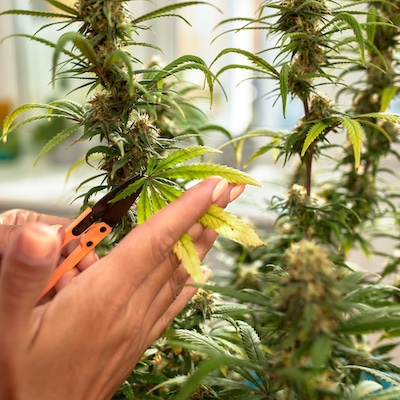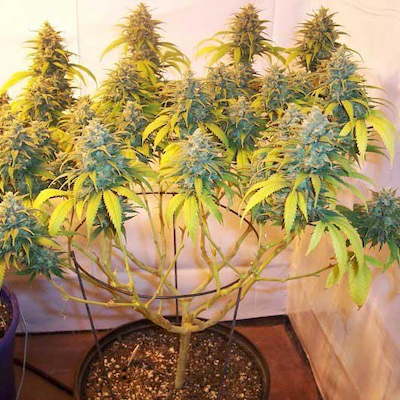BackThe perfect time for lollipopping: when, how and why to prune
03.07.2025

In the world of cannabis cultivation, few techniques generate as much debate as lollipopping, a seemingly simple practice that consists of eliminating the lower growth of the plants to concentrate all their energy on the upper buds. However, behind this apparent simplicity lies an art that requires precision, choosing the perfect timing, and a deep understanding of the physiology of cannabis.
When you grow cannabis, there is a belief, especially among rookie growers, that "more is always better". More branches, more leaves, more foliage... Everything seems to point towards a larger plant and therefore a more abundant harvest. However, experienced growers know that the path to a championship crop is not based on accumulation but on optimisation. This is where lollipopping stops being a simple clipping technique and becomes more of an art form… An intimate and strategic dialogue with the plant to interpret its energy flows and intervene with the precision of a surgeon at the perfect moment to sculpt a crop of superior quality. The lollipopping technique, whose name evokes the shape of a lollipop (i.e., bare stems holding dense and heavy colas), is a pruning method that seeks to eliminate lower unproductive growth to ensure that the plant doesn’t waste its limited energy on buds that will never fully mature. Mastering this technique will not only increase the weight of your crop but will also transform its quality, leading to flowers that are larger, denser, tastier, and more potent.
Physiology and the energy flow of cannabis
To prune with intention and not merely by imitation, it is essential to understand the internal logic of the cannabis plant. Imagine your plant not as a static structure but as a complex biological factory with a limited energy budget, where every decision you make influences how it allocates its valuable resources. The engine of this factory is the leaves, which act like solar panels. Through photosynthesis, they convert light into chemical energy (glucose), which is the fuel that feeds every vital process. This energy, along with the water and nutrients absorbed by the roots, is distributed throughout the plant via the stem, which functions as a backbone and a network of motorways. However, this distribution is not equitable ― it is governed by a fundamental biological principle known as "apical dominance". The main tip of the plant, the apical meristem, produces a high concentration of auxins. These key hormones flow down the stem, promoting vigorous vertical growth as well as actively inhibiting the development of lower side branches. It is nature’s way of ensuring that the plant grows towards the light as quickly as possible. So, here’s where the problem lies for the grower who seeks maximum efficiency. The lower branches, hormonally suppressed by the apical dominance and perpetually in the shade of the upper canopy, receive an insufficient amount of light to carry out an effective photosynthesis. Instead of contributing to the energy budget of the plant, they become "net energy drains": they use more resources (water, nutrients, and energy) than they generate, becoming a biological burden. And these lower flowers, often called "popcorn buds", will never reach a significant size, density, or potency. By removing these lower branches and shoots, we achieve two crucial goals simultaneously. Firstly, we root out the energy drain that they represent. Secondly, we alter the hormonal balance ― the plant stops sending resources to those now non-existent areas, with the plant’s vascular system redirecting them upwards, towards the upper colas that enjoy full light and have the greatest yielding potential. What’s more, by eliminating dense lower growth, a more efficient airflow is created around the plant, significantly reducing the risk of fungi and other pathogens. In essence, we’re hacking into the plant’s logistics system to force a total reversal of its most valuable assets.
The window of opportunity to synchronise pruning with the rhythm of the plant
The effectiveness of lollipopping depends almost entirely on when it is done. An untimely intervention can cause more harm than benefit, stressing the plant at a vulnerable time and reducing the crop you intended to improve. The key is to synchronise your action with the biological rhythm of the plant, acting within a very specific window of opportunity when the plant is resilient enough to recover. For photo-dependent varieties, this window is found in the transition between the vegetative and the flowering phase. Within this period, there are two expert approaches:
- The first, a proactive strategy which consists of performing the main pruning between 5 and 7 days before changing the photoperiod to 12/12. This gives the plant a few crucial days to recover and heal any wounds while it is still in its growth stage. This ensures that, when flowering begins, it can devote 100% of its energy to stretching and to the initial formation of buds free from any distractions.
- The second, more reactive approach is performed during the first phase of flowering, specifically during the "stretching”, which covers approximately the first two to three weeks after the change to 12/12. At this point, the plant defines its final structure, so the grower can check which branches have enough vigour to reach the canopy, and which ones will be relegated to the shade, allowing for a more precise pruning.
Both times are equally valid, but what all experts agree on is the danger zone: performing an intensive pruning after the third week of flowering is a critical error. By then, the plant has already invested energy in these lower flowers, and a late pruning can cause such severe stress that it can stop the fattening of the upper buds or induce a response of hermaphroditism as a survival mechanism.
Practical guide for precise and safe lollipopping
Cutting your precious plants with scissors can be intimidating, but the key lies in careful preparation and methodical execution. Start with the obvious: remove any yellowish or dying leaves and the lower and weaker branches that barely rise from the substrate. To decide how much foliage to remove, experts often combine several methods. A good starting point is to clear all the growth in the lower third of the plant’s total height, as that area is most likely to receive insufficient light. A more refined rule, made popular by grower Kyle Kushman, suggests eliminating any branch that doesn’t reach at least 50% of the total height of the plant, as it will remain shaded and unproductive. Another method involves counting down from the tip of each main branch, leaving only between three to six nodes and eliminating everything that grows below. When making cuts, make them clean and flush with the main stem to avoid leaving stumps that can rot. If it’s your first time, be conservative ― you can always remove a little more later, but you can never undo a cut.
Postoperative care and additional considerations
After pruning, the plant needs a period of calm to recover. Avoid subjecting it to other types of stress, such as transplants or sudden changes in temperature. A crucial adjustment is irrigation: after having removed some leaf mass, the plant will need less water, so you must monitor the moisture of the substrate to avoid waterlogging it. Nutrition also needs to be adjusted, perhaps with a more diluted dose of fertiliser during the first few days. The way in which the plant responds is the best indicator of success. A burst of vigorous growth in the upper buds after a few days is the best sign that the energy has been redirected correctly. This optimisation technique reaches its maximum potential when combined with methods such as SCROG (Screen of Green), where eliminating all the growth under the mesh is essential for the energy to be focused on the upper canopy.
In short, mastering the lollipopping technique represents a qualitative leap, the point at which you go from simply "growing" to actively "sculpting" the final result. It is about learning how to communicate with your plants, reading their needs and intervening to help them reach their maximum genetic potential, thereby becoming collaborators and artists of the nature of cannabis.

